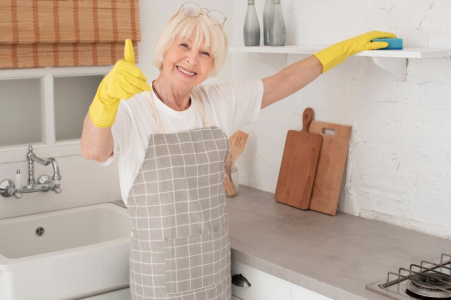Clean smarter, not harder! Here's how the '20/10' cleaning method prevents exhaustion
By
VanessaC
- Replies 6
If you tend to feel overwhelmed when faced with a messy home, you’re not alone.
Many find it difficult to know where to start and how to clean effectively without wearing themselves out.
The good news is that one of the best cleaning methods out there is designed just for people prone to cleaning fatigue, and it’s called the 20/10 cleaning method!
This technique is mentioned in organisation expert Rachel Hoffman’s 2017 book Unf**k Your Habitat: You’re Better Than Your Mess.
The book's title offers motivation and reassurance for people struggling with clutter and mess. While Hoffman outlines many useful approaches in her book, the 20/10 method is a cornerstone.
At its core, similar to the Pomodoro technique, the 20/10 cleaning method means working for 20 minutes then taking a ten-minute break. The work-rest ratio allows you to maximise your cleaning productivity without crossing the threshold of exhaustion.
Studies show that taking short breaks is crucial for maintaining energy and focus. Research has found that concentration wanes after 20 minutes, so switching tasks or resting is optimal.
Working too much, too hard, for too long puts one at risk of burning out and giving up, so a brief ten-minute break to just relax will give one’s mind and body time to recharge before the next cleaning chunk.
To implement the 20/10 method, set a timer for 20 minutes and tackle one section or task, like cleaning the kitchen counters.
When the timer goes off, set another timer for 10 minutes and take a break. Have a snack, scroll on social media, or just sit down and enjoy the clean kitchen.
Then, it’s back to a 20-minute cleaning session for the next area.
The 20/10 method is perfect for breaking down big jobs like cleaning the whole house into manageable pieces—tackle one room or surface at a time without getting burnt out. Getting a small sense of completion after each 20-minute task will give you a sense of progress—and little by little, the job will eventually get done.
Moreover, to avoid sabotaging your cleaning efforts—especially in the kitchen!—expert Sarah Karakaian gave some helpful advice.
According to Karakaian, it’s best to stick to wiping, scrubbing, and sweeping from top to bottom when cleaning kitchens rather than going from the bottom up, as gravity tends to send grime downward.
Cleaning from the top down is also an excellent way to help you stay focused, as it can be overwhelming when you have a whole kitchen full of cleaning to do.
This method helps remove the panicked feeling of not knowing where to start.
You can read more about this method here.

Will you be trying the 20/10 cleaning method? Don’t forget to share your experience with us in the comments below!
Many find it difficult to know where to start and how to clean effectively without wearing themselves out.
The good news is that one of the best cleaning methods out there is designed just for people prone to cleaning fatigue, and it’s called the 20/10 cleaning method!
This technique is mentioned in organisation expert Rachel Hoffman’s 2017 book Unf**k Your Habitat: You’re Better Than Your Mess.
The book's title offers motivation and reassurance for people struggling with clutter and mess. While Hoffman outlines many useful approaches in her book, the 20/10 method is a cornerstone.
At its core, similar to the Pomodoro technique, the 20/10 cleaning method means working for 20 minutes then taking a ten-minute break. The work-rest ratio allows you to maximise your cleaning productivity without crossing the threshold of exhaustion.
Studies show that taking short breaks is crucial for maintaining energy and focus. Research has found that concentration wanes after 20 minutes, so switching tasks or resting is optimal.
Working too much, too hard, for too long puts one at risk of burning out and giving up, so a brief ten-minute break to just relax will give one’s mind and body time to recharge before the next cleaning chunk.
To implement the 20/10 method, set a timer for 20 minutes and tackle one section or task, like cleaning the kitchen counters.
When the timer goes off, set another timer for 10 minutes and take a break. Have a snack, scroll on social media, or just sit down and enjoy the clean kitchen.
Then, it’s back to a 20-minute cleaning session for the next area.
The 20/10 method is perfect for breaking down big jobs like cleaning the whole house into manageable pieces—tackle one room or surface at a time without getting burnt out. Getting a small sense of completion after each 20-minute task will give you a sense of progress—and little by little, the job will eventually get done.
Moreover, to avoid sabotaging your cleaning efforts—especially in the kitchen!—expert Sarah Karakaian gave some helpful advice.
According to Karakaian, it’s best to stick to wiping, scrubbing, and sweeping from top to bottom when cleaning kitchens rather than going from the bottom up, as gravity tends to send grime downward.
Cleaning from the top down is also an excellent way to help you stay focused, as it can be overwhelming when you have a whole kitchen full of cleaning to do.
This method helps remove the panicked feeling of not knowing where to start.
You can read more about this method here.
Key Takeaways
- The 20/10 rule is an effective and simple cleaning method, which involves cleaning for 20 minutes and resting for 10 minutes.
- This cleaning method is mentioned in Rachel Hoffman’s 2017 book, Unf**k Your Habitat: You’re Better Than Your Mess.
- The technique is similar to productivity methods like the Pomodoro technique but focuses on cleaning specific areas for 20-minute bursts.
- The ten-minute break is a crucial part of the method, encouraging an enjoyment of the cleaned space and providing time to recharge before the next cleaning segment.
Last edited:








